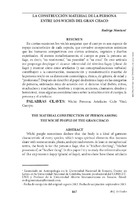La construcción material de la persona entre los Wichís del Gran Chaco
Abstract
En ciertas ocasiones los wichís aseguran que el cuerpo es una especie de ropaje característico de cada especie, que envuelve componentes anímicos que los humanos compartimos con ciertos animales, vegetales y dueños espirituales. Al menos metafóricamente, el cuerpo es para la persona un laqo, es decir, “su vestimenta”, “su posesión” o “su cosa”. En este artículo me propongo desplegar el alcance referencial del término laqoy (plural de laqo) y mostrar cómo estos artefactos (y sus conceptualizaciones verbales) contribuyen a la construcción, manutención y transformación material de la persona wichí en su dimensión cosmológica, étnica, de género, de edad y “profesional”. Después de describir el papel de distintos laqoy en las categorías de persona, ordenadas éstas de acuerdo con el decurso vital (bebés, niños, muchachos y muchachas, hombres y mujeres, ancianos, chamanes, deudos y herederos), trazo algunas consideraciones sobre la relación entre el cuerpo, la persona y el artefacto. Wichí people sometimes declare that the body is a kind of garment characteristic of every species, which wraps spiritual elements that humans share with some animals, plants, and spiritual owners. At least in metaphorical terms, the body is for the person a laqo, that is “his/her clothing”, “his/her possession”, or “his/her thing”. In this paper I try to study the referential scope of the expression laqoy (plural of laqo), and to show how these artifacts (and their verbal conceptualizations) contribute to the process of material building, maintaining, and transformation of Wichí person in his/her cosmological, ethnic, gender, age, and “professional” dimensions. After describing the roles of different laqoy in the different categories of the person ordering them in terms of the vital cycle (babies, children, boys and girls, men and women, elderly people, shamans, mourning relatives, and heirs), I draw some considerations about the meaningful link between body, person and artifact.
Collections
- Revista Avá [337]




